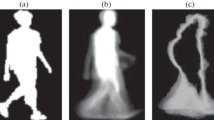Abstract
The reliable identification of human activities in video, for example whether a person is walking, clapping, waving, etc. is extremely important for video interpretations. Since different people could perform the same action across different number of frames, matching two different sequences of the same actions is not a trivial task. In this paper we discuss a new technique for video sequence matching where the matched sequences are of different sizes. The proposed technique is based on frequency domain analysis of feature data. The experiments are shown to achieve high recognition accuracy of 95.4% on recognizing 8 different human actions, and out-perform two baseline methods of comparison.
Preview
Unable to display preview. Download preview PDF.
Similar content being viewed by others
References
Agrawal, R., Faloutsos, C., Swami, A.: Efficiet Similarity Search In Sequence Databases. In: Proceedings of the 4th International Conference of Foundations of Data Organization and Algorithms (FODO), Chicago, October 1993, pp. 69–84 (1993)
Beckmann, N., Kriegel, H.-P., Schneider, R., Seeger, B.: The R* -tree: An Efficient and Robust Access Method for Points and Rectangles. In: Proc. Int’l Conf. On Management of Data, ACM SIGMOD, Atlantic City, New Jersey, May 1990, pp. 322–331 (1990)
Ben-Arie, J., Wang, Z., Pandit, P., Rajaram, S.: Human Activity Recognition Using Multidimensional Indexing. IEEE Transactions on Pattern Analysis and Machine Intelligence 24(8), 1091–1104 (2002)
Chan, K.-P., Fu, A.W.-C.: Efficient Time Series Matching by Wavelets. In: 15th IEEE International Conference on Data Engineering, Sydney, Australia, March 1999, pp. 126–133 (1999)
Duda, R., Hart, P.E., Stork, D.: Pattern Classification, 2nd edn. John Wiley and Sons, New York (2001)
Faloutsos, C., Ranganathan, M., Manolopoulos, Y.: Fast subsequence matching in Time-series Databases. In: Proceedings 1994 ACM SIGMOD Conference, Minneapolis, MN, pp. 419–429 (1994)
Horprasert, T., Harwood, D., Davis, L.S.: A statistical App. roach for Real-time Robust Background Subtraction and Shadow Detection. In: Proceeding of IEEE ICCV 1999, pp. 1–19 (1999)
Kim, S.H., Park, R.-H.: An Efficient Algorithm For Video Sequence Matching Using The Modified Hausdorff Distance and the Directed Divergence. IEEE Transactions on Circuits and Systems for Video Technology 12(7), 592–296 (2002)
Moon, Y.-S., Whang, K.-Y., Loh, W.-K.: Efficient Time-Series Subsequence Matching using Duality in Constructing Windows. Information Systems 26(4), 279–293 (2001)
Moon, Y.-S., Whang, K.-Y., Loh, W.-K.: Dual Match: Duality-Based Subsequence Matching in Time-series Databases. In: Proceedings of the 17th International Conference on Data Engineering, pp. 263–272 (April 2001)
Rafiei, D., Mendelzon, A.: Similarity-based Queries for Time series Data. In: Proc. Int’l Conf. On Management of Data, ACM SIGMOD, Tucson, Arizona, pp. 13–25 (May 1997)
Rafiei, D.: On similarity-based queries for time series data. In: Proc. The 15th Int’l Conf. On Data Engineering, Sydney, Australia, pp. 410–417 (February 1999)
Rangarajan, K., Allen, B., Shah, M.: Matching Motion Trajectories. Pattern Recognition 26(4), 595–610 (1993)
Savnik, I., Lausen, G., Kahle, H.-P., Spiecker, H., Hein, S.: Algorithm for Matching Sets of Time Series. In: Principles of Data Mining and Knowledge Discovery, Lyon, France, pp. 277–288 (September 2000)
Sonka, M., Hlavac, V., Boyle, R.: Image Processing, Analysis and Machine Vision, ch. 6. Brooks/Cole Publishing (1999)
Tolba, A.: Arabic Glove Talk: A Communication Aid for Vocally Impaired. Pattern Analysis and Applications 1(4), 218–230 (1998)
Tsai, P.-S., Shah, M., Keiter, K., Kasparis, T.: Cyclic Motion Detection. Department of Computer Science Technical Report, University of Central Florida, Orlando (1993)
Wang, J., Singh, S.: Video Based Human Dynamics: A Review. Real Time Imaging 9(5), 321–346 (2003)
Wang, J., Singh, S.: Video Based Human Behavior Identification using Frequency Domain Analysis. In: Yang, Z.R., Yin, H., Everson, R.M. (eds.) IDEAL 2004. LNCS, vol. 3177, pp. 218–224. Springer, Heidelberg (2004)
Author information
Authors and Affiliations
Editor information
Editors and Affiliations
Rights and permissions
Copyright information
© 2005 Springer-Verlag Berlin Heidelberg
About this paper
Cite this paper
Wang, J.J., Singh, S. (2005). Spatial Feature Based Recognition of Human Dynamics in Video Sequences. In: Singh, S., Singh, M., Apte, C., Perner, P. (eds) Pattern Recognition and Image Analysis. ICAPR 2005. Lecture Notes in Computer Science, vol 3687. Springer, Berlin, Heidelberg. https://doi.org/10.1007/11552499_10
Download citation
DOI: https://doi.org/10.1007/11552499_10
Publisher Name: Springer, Berlin, Heidelberg
Print ISBN: 978-3-540-28833-6
Online ISBN: 978-3-540-31999-3
eBook Packages: Computer ScienceComputer Science (R0)




